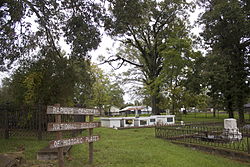Rapides Cemetery | |
 Sign at entry of Rapides Cemetery in 2012 | |
| Location | Hardtner and Main Sts., Pineville, Louisiana |
|---|---|
| Coordinates | 31°19′0″N92°26′30″W / 31.31667°N 92.44167°W |
| Area | 7 acres (2.8 ha) |
| Architectural style | Victorian Gothic Funerary |
| NRHP reference No. | 79001088 |
| Added to NRHP | 15 June 1979 [1] |
Rapides Cemetery is a historic burial ground located in Pineville, Louisiana at the site of the colonial era Post of Rapides.


